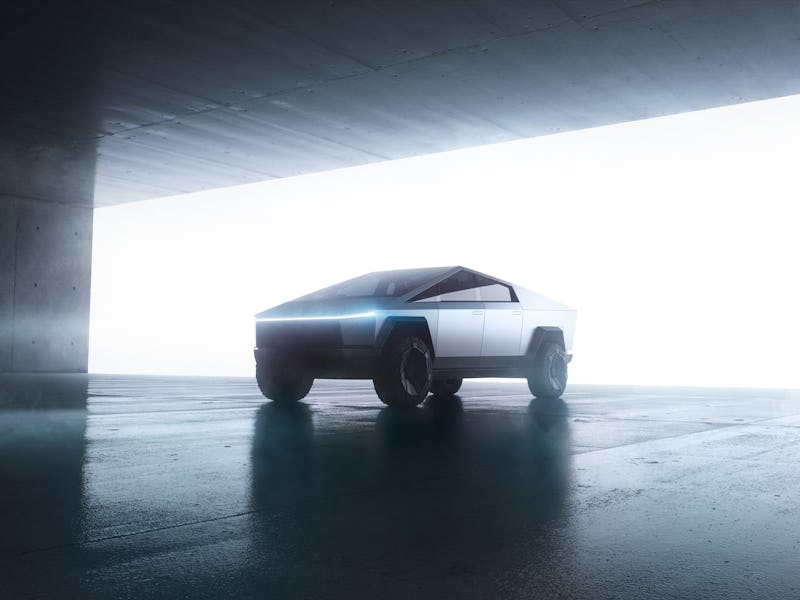Tesla Cybertruck: Elon Musk sets ‘insane’ target for drag coefficient
The CEO is aiming for a low drag coefficient.

The Tesla Cybertruck could breeze through the air, CEO Elon Musk suggested over the weekend.
The company’s upcoming all-electric pickup truck, due to start manufacturing in late 2021, could attract buyers with a competitive $39,900 price point. That could give the Ford F-series, the best-selling vehicle in the United States for the last 42 years, a serious run for its money. It also sports a rather unusual design, thanks to its 30X cold-rolled steel that leads to a strangely angular shape.
But that design could hold benefits for the car’s aerodynamics. On Sunday, Musk wrote on Twitter that “with extreme effort,” the Cybertruck could offer a drag coefficient of 0.30, “which would be insane for a truck.” Musk noted, however, that reaching that figure “requires tweaking many small details.” For a pickup truck, it would be a particularly impressive feat — the 2018 RAM 1500 claims its coefficient of 0.36 is best in class.
Drag coefficient measures the amount of resistance an object faces from air, which means a lower number is better. It’s a number that has become a key point of focus for Tesla fans, as a more aerodynamic vehicle could mean an electric car that moves further between charges. But after a now-removed fan-made analysis video last week made some bold claims about the Cybertruck’s performance, one expert has warned that the drag coefficient is not the be-all and end-all for aerodynamic design.
Tesla Cybertruck aerodynamics video shared last week.
Tesla Cybertruck: Elon Musk’s race to reduce the drag
The Cybertruck’s angular design, unveiled last month at the Tesla Design Studio in Los Angeles, could offer big benefits for aerodynamics. Musk responded on Twitter to a question about the flat back and nose, which user “Everyday Astronaut” suggested can’t be good for aerodynamics:
Overall shape is good for low drag coefficient. Matters a lot exactly how you trip airflow at edges & guide air around wheels, like an invisible sculpture.
Musk's exchange on Twitter.
Musk also responded to an analysis of the Cybertruck, which suggested that it could glide smoother than a Ram or a Raptor pickup truck. Musk wrote that “laminar air flow due to a completely smooth bottom is underappreciated.”
The analysis of the Tesla Cybertruck versus other cars.
It’s not the first time that Musk and Tesla have focused on drag coefficient as a metric of their vehicles’ efficiency.
The 2012 Tesla Model S offered a measurement of 0.24. For the Model 3 in 2017, Tesla aimed for a rating of 0.21. The final vehicle hit a figure of 0.23.
The Model 3 is an example of how Tesla has shifted focus away from sheer battery size and more toward explaining how far each vehicle can move per charge. Unlike the Model S and X, which are sold based on battery size, the Model 3 focuses on battery range. A Model 3 with a 62-kilowatt-hour battery was sold in October 2018 as traveling 60 more miles than a Model S with comparable battery size.
Tesla has continued focusing on drag coefficient with the Tesla Semi. The all-electric truck is set to offer a coefficient of 0.36. Tesla highlighted how this is lower than the Bugatti Chiron’s coefficient of 0.38.
Tesla Semi: glides through the air?
This focus on drag coefficient has filtered into the fan community, with fans on LinkedIn and Reddit attempting to find the Cybertruck’s figure for themselves. This came to the forefront last week, when a YouTube account called “Aerospace Engineering” shared a video that simulated the truck using computational fluid dynamics software, which claimed the drag coefficient could reach around 0.38.
Unfortunately, the video in question may not reach the right conclusions. David Sims-Williams, a Durham University professor whose research interests include road and racing car aerodynamics, tells Inverse that automotive manufacturers complete more accurate simulations with detailed geometry knowledge and thousands of hours of processing — something that did not appear to be on display in the video.
“This does not have enough detail of the simulation method to have confidence in a prediction of the drag coefficient I’m afraid,” Sims-Williams says. “The value quoted might be plausible, but I did not see evidence to have confidence in it.”
Tesla Cybertruck.
The focus on the coefficient could also mask the benefits of other improvements. Chris Baker, a professor of environmental fluid mechanics at the University of Birmingham, told Inverse on Friday that while the concept of drag coefficient is “useful,” it “says nothing” about how cross winds could change drag or overall energy consumption.
The Cybertruck is expected to offer over 500 miles of range in its most expensive iteration, more than any other vehicle currently sold by Tesla. A lower drag coefficient is cool, but in terms of real-world use, the figure that’s more likely to grab consumer attention is more miles per charge.